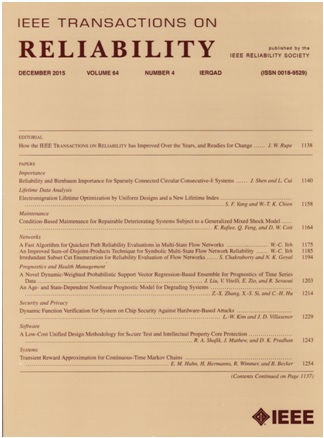Dynamic Reliability Assessment of Hierarchical Multistate Systems With Sensors’ Degradation
IF 5.7
2区 计算机科学
Q1 COMPUTER SCIENCE, HARDWARE & ARCHITECTURE
引用次数: 0
Abstract
Engineered systems are increasingly integrating sensor techniques to trace their specific degradation behaviors, so as to facilitate their dynamic reliability assessment. Due to the hierarchical structure of these systems, sensing data can be collected at multiple physical levels, including the entire system, subsystems, and components. The quality of collected multilevel sensing data, however, decreases inevitably with the degradation of sensors mounted within each system, leading to a declining trustworthiness of dynamic reliability assessment for each specific individual system. This article develops a new dynamic reliability assessment framework of hierarchical multistate systems suffering from sensors’ degradation. The proposed framework mainly contains three steps: 1) utilizing discrete-state and continuous-state stochastic processes to, respectively, model the degradation behaviors of two types of sensors; 2) integrating these two types of sensors’ degradation models to update the joint state probability distribution of both the monitored objects and sensors by fusing multilevel sensing data; 3) deriving the marginal state probability distribution of the entire system to dynamically assess system reliability. A three-component system and an electromechanical actuator system in landing gear systems are exemplified to illustrate the performance of the proposed method.考虑传感器退化的分层多状态系统动态可靠性评估
工程系统越来越多地集成传感器技术来跟踪其特定的退化行为,从而促进其动态可靠性评估。由于这些系统的分层结构,传感数据可以在多个物理层收集,包括整个系统、子系统和组件。然而,随着每个系统内安装的传感器的退化,所收集的多层传感数据的质量不可避免地下降,导致每个特定单个系统动态可靠性评估的可信度下降。本文提出了一种新的受传感器退化影响的分层多状态系统动态可靠性评估框架。该框架主要包括三个步骤:1)分别利用离散状态和连续状态随机过程对两类传感器的退化行为进行建模;2)融合两类传感器的退化模型,通过融合多层次传感数据,更新被监测对象和传感器的联合状态概率分布;3)推导整个系统的边际状态概率分布,动态评估系统可靠性。以起落架系统中的三部件系统和机电致动器系统为例,说明了该方法的有效性。
本文章由计算机程序翻译,如有差异,请以英文原文为准。
求助全文
约1分钟内获得全文
求助全文
来源期刊

IEEE Transactions on Reliability
工程技术-工程:电子与电气
CiteScore
12.20
自引率
8.50%
发文量
153
审稿时长
7.5 months
期刊介绍:
IEEE Transactions on Reliability is a refereed journal for the reliability and allied disciplines including, but not limited to, maintainability, physics of failure, life testing, prognostics, design and manufacture for reliability, reliability for systems of systems, network availability, mission success, warranty, safety, and various measures of effectiveness. Topics eligible for publication range from hardware to software, from materials to systems, from consumer and industrial devices to manufacturing plants, from individual items to networks, from techniques for making things better to ways of predicting and measuring behavior in the field. As an engineering subject that supports new and existing technologies, we constantly expand into new areas of the assurance sciences.
 求助内容:
求助内容: 应助结果提醒方式:
应助结果提醒方式:


